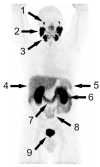The Role of PSMA PET/CT in the Primary Diagnosis and Follow-Up of Prostate Cancer-A Practical Clinical Review
- PMID: 35892897
- PMCID: PMC9367536
- DOI: 10.3390/cancers14153638
The Role of PSMA PET/CT in the Primary Diagnosis and Follow-Up of Prostate Cancer-A Practical Clinical Review
Abstract
The importance of PSMA PET/CT in both primary diagnostics and prostate cancer recurrence has grown steadily since its introduction more than a decade ago. Over the past years, a vast amount of data have been published on the diagnostic accuracy and the impact of PSMA PET/CT on patient management. Nevertheless, a large heterogeneity between studies has made reaching a consensus difficult; this review aims to provide a comprehensive clinical review of the available scientific literature, covering the currently known data on physiological and pathological PSMA expression, influencing factors, the differences and pitfalls of various tracers, as well as the clinical implications in initial TNM-staging and in the situation of biochemical recurrence. This review has the objective of providing a practical clinical overview of the advantages and disadvantages of the examination in various clinical situations and the body of knowledge available, as well as open questions still requiring further research.
Keywords: PET; PET/CT; PSMA; PSMA PET/CT; prostate cancer; prostate-specific membrane antigen.
Conflict of interest statement
The authors declare no conflict of interest.
Figures


References
-
- Kahn D., Williams R.D., Seldin D.W., Libertino J.A., Hirschhorn M., Dreicer R., Weiner G.J., Bushnell D., Gulfo J. Radioimmunoscintigraphy with 111 Indium Labeled Cyt-356 for the Detection of Occult Prostate Cancer Recurrence. J. Urol. 1994;152:1490–1495. doi: 10.1016/S0022-5347(17)32453-9. - DOI - PubMed
-
- Smith-Jones P.M., Vallabahajosula S., Goldsmith S.J., Navarro V., Hunter C.J., Bastidas D., Bander N.H. In vitro characterization of radiolabeled monoclonal antibodies specific for the extracellular domain of prostate-specific membrane antigen. Cancer Res. 2000;60:5237–5243. - PubMed
-
- Maresca K.P., Hillier S.M., Femia F.J., Keith D., Barone C., Joyal J.L., Zimmerman C.N., Kozikowski A.P., Barrett J.A., Eckelman W.C., et al. A Series of Halogenated Heterodimeric Inhibitors of Prostate Specific Membrane Antigen (PSMA) as Radiolabeled Probes for Targeting Prostate Cancer. J. Med. Chem. 2009;52:347–357. doi: 10.1021/jm800994j. - DOI - PubMed
-
- Hillier S.M., Maresca K.P., Femia F.J., Marquis J.C., Foss C.A., Nguyen N., Zimmerman C.N., Barrett J.A., Eckelman W.C., Pomper M.G., et al. Preclinical Evaluation of Novel Glutamate-Urea-Lysine Analogues That Target Prostate-Specific Membrane Antigen as Molecular Imaging Pharmaceuticals for Prostate Cancer. Cancer Res. 2009;69:6932–6940. doi: 10.1158/0008-5472.CAN-09-1682. - DOI - PMC - PubMed
Publication types
LinkOut - more resources
Full Text Sources
Miscellaneous

